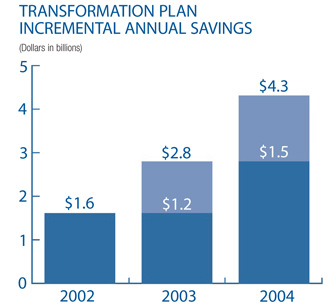 |
page 28 of 55 |  |
financial review
Part II
|
Other Developments TRANSFORMATION PLAN In April 2002, we submitted to the President of the United States and Congress our Transformation Plan that analyzes both the challenges facing the Postal Service and the future viability of the institution. Since that time, the Transformation Plan has served as the blueprint for every aspect of our business. This blueprint has focused on what we can do in the near-term, without legislative reform, to fulfill our legislative mandate to "bind the Nation together through the personal, educational, literary, and business correspondence of the people." The transformation strategies have helped us achieve our transformation goals: foster growth through customer value, increase operational efficiency, move toward a performance--based culture, and restructure enabling functions. The success of transformation is visible today throughout our organization. We have completed some strategies identified in the 2002 Plan. We are continuing to integrate some strategies into our normal organizational processes and procedures, while we have discontinued a few after analyzing them. We are on track to meet and perhaps even exceed our $5 billion savings commitment we made in the 2002 Transformation Plan. Through 2004 the estimated incremental annual savings are $4.3 billion. Cumulatively, that equates to $8.7 billion for the first three years of the Transformation Plan. At the same time, we have achieved record-breaking service nationwide and historically high employee satisfaction scores on Voice of the Employee surveys. Enhancements to core products and services helped mitigate the decline in revenue associated with the loss of First-Class Mail volume. In addition, the Postal Service has reduced its outstanding debt from $11.3 billion at the end of 2001 to $1.8 billion at the end of 2004. These transformation achievements, along with five years of increased productivity, have allowed mailers to enjoy rate stability since June 2002. Transformation of the Postal Service is succeeding and will continue to drive further improvements. EVOLUTIONARY NETWORK DEVELOPMENT In our mission to provide universal mail service, we manage one of the largest and most complex logistics networks in the world. As we have worked to meet the demands of a growing nation, our network has grown and evolved into a structure based on a mixture of factors, such as the mail class and the shape of the pieces of mail. Today we face relatively stagnant overall mail volume with the volumes of some classes of mail increasing while others decrease. |
In response, we have developed what we call an Evolutionary Network Development (END) process with which we will respond to the challenges of declining mail volumes, aging infrastructure, network redundancies and operating inefficiencies. END will enable us to create a flexible logistics network that reduces our costs, increases overall operational effectiveness, and improves consistency of service. Through END, we can bring postal management, mailers, and industry experts together to improve network operations by locating and eliminating inefficiencies in our systems and processes, as well as find new ways to improve our services. The END initiative is one of the core sub-strategies in our Transformation Plan. It is an investment in developing a network optimization infrastructure that will enable us to keep our mail processing and transportation networks efficient and our systems affordable. Outlook We believe the 2005 economic environment will be relatively favorable, with growth in economic output and aggregate demand, and moderate inflation. Also, 2005 will be the third year since the last increase in postal prices. Led by Standard Mail, we expect total mail volume to grow about 1%. But despite favorable economic circumstances, we project First-Class Mail volume will continue to decline. |
